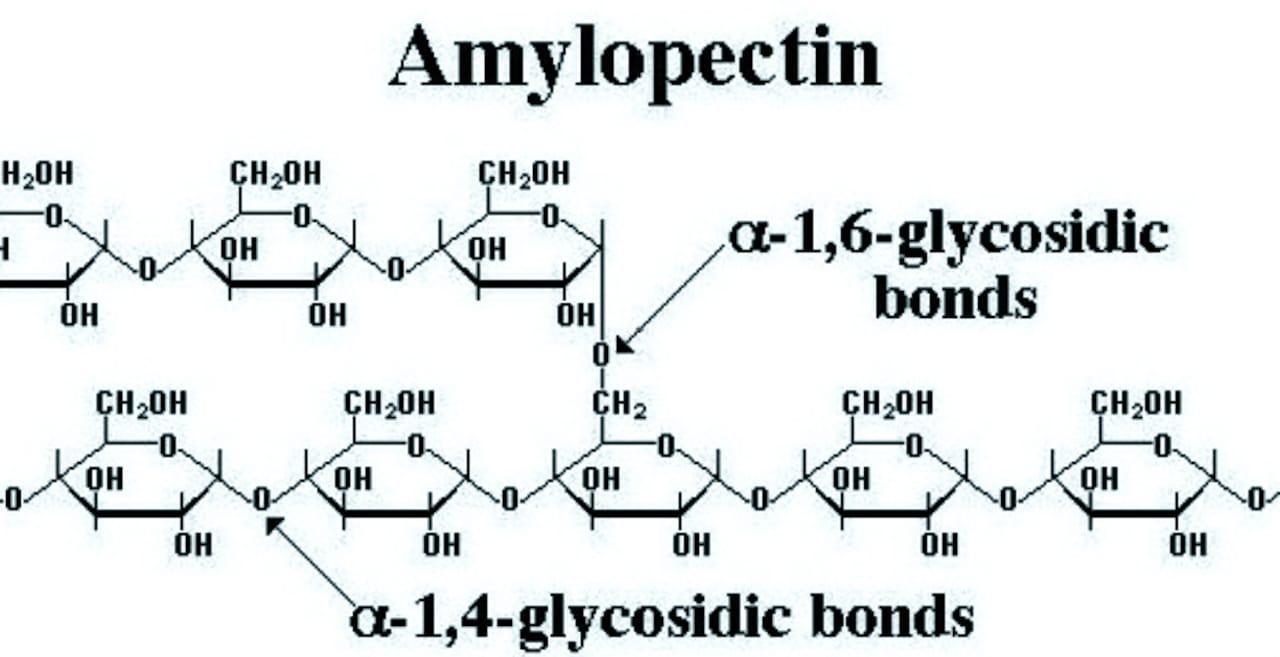
The difference between amylase and amylopectin is __________.
(a)- \[Amylopectin\text{ }have\text{ }1\to 4\alpha -linkage\text{ }and\text{ }1\to 6\beta -linkage\]
(b)- \[Amylopectin\text{ }have\text{ }1\to 4\alpha -linkage\text{ }and\text{ }1\to 6\alpha -linkage\]
(c)- Amylose is made up of glucose and galactose.
(d)- \[Amylose\text{ }have\text{ }1\to 4\alpha -linkage\text{ }and\text{ }1\to 6\beta -linkage\]
Answer
141.3k+ views
Hint: One of the following has the branched-chain structure and one has the linear chain structure. Both of them are made up of glucose components only.
Complete step by step answer:
Starch is not only a single compound but is a mixture of two components-a water-soluble components called amylose (15-20%) and a water-insoluble component called amylopectin (80-85%). The aqueous solution of amylose gives a blue color with an iodine solution. Amylopectin, on the other hand, does not give blue color with iodine solution.
Structure of amylose: It is a linear polymer of \[\alpha -D-glu\cos e\] in which\[{{C}_{1}}\] of one glucose unit is attached to\[{{C}_{4}}\] of the other through\[\alpha -gly\cos idic\] linkage.

Structure of amylopectin: Amylopectin, on the other hand, is a highly branched polymer. It consists of a large number of short chains each containing 20-25 glucose units which are joined together through \[\alpha -gly\cos idic\] linkage involving \[{{C}_{1}}\] of one glucose unit with\[{{C}_{4}}\] of the other. The \[{{C}_{1}}\]of the terminal glucose unit in each chain is further linked to\[{{C}_{6}}\] of some other glucose unit in the next chain through \[{{C}_{1}}-{{C}_{6}}\]\[\alpha -gly\cos idic\] linkage. This gives amylopectin a highly branched structure.

Hence, from the above discussion option (b) is correct.
Note: You may get confused between \[\alpha -linkage\] and \[\beta -linkage\]. \[\alpha -linkage\] is formed when the bond is formed on the same side and \[\beta -linkage\]is formed when the bond is formed between the opposite side.
Complete step by step answer:
Starch is not only a single compound but is a mixture of two components-a water-soluble components called amylose (15-20%) and a water-insoluble component called amylopectin (80-85%). The aqueous solution of amylose gives a blue color with an iodine solution. Amylopectin, on the other hand, does not give blue color with iodine solution.
Structure of amylose: It is a linear polymer of \[\alpha -D-glu\cos e\] in which\[{{C}_{1}}\] of one glucose unit is attached to\[{{C}_{4}}\] of the other through\[\alpha -gly\cos idic\] linkage.

Structure of amylopectin: Amylopectin, on the other hand, is a highly branched polymer. It consists of a large number of short chains each containing 20-25 glucose units which are joined together through \[\alpha -gly\cos idic\] linkage involving \[{{C}_{1}}\] of one glucose unit with\[{{C}_{4}}\] of the other. The \[{{C}_{1}}\]of the terminal glucose unit in each chain is further linked to\[{{C}_{6}}\] of some other glucose unit in the next chain through \[{{C}_{1}}-{{C}_{6}}\]\[\alpha -gly\cos idic\] linkage. This gives amylopectin a highly branched structure.

Hence, from the above discussion option (b) is correct.
Note: You may get confused between \[\alpha -linkage\] and \[\beta -linkage\]. \[\alpha -linkage\] is formed when the bond is formed on the same side and \[\beta -linkage\]is formed when the bond is formed between the opposite side.
Recently Updated Pages
Classification of Drugs Based on Pharmacological Effect, Drug Action

Difference Between Alcohol and Phenol

JEE Main Participating Colleges 2024 - A Complete List of Top Colleges

JEE Main Maths Paper Pattern 2025 – Marking, Sections & Tips

Sign up for JEE Main 2025 Live Classes - Vedantu

JEE Main 2025 Helpline Numbers - Center Contact, Phone Number, Address

Trending doubts
JEE Main 2025 Session 2: Application Form (Out), Exam Dates (Released), Eligibility, & More

JEE Main Exam Marking Scheme: Detailed Breakdown of Marks and Negative Marking

JEE Main 2025: Derivation of Equation of Trajectory in Physics

Electric Field Due to Uniformly Charged Ring for JEE Main 2025 - Formula and Derivation

Types of Solutions

Learn About Angle Of Deviation In Prism: JEE Main Physics 2025

Other Pages
NCERT Solutions for Class 12 Chemistry Chapter 6 Haloalkanes and Haloarenes

NCERT Solutions for Class 12 Chemistry Chapter 2 Electrochemistry

NCERT Solutions for Class 12 Chemistry Chapter 7 Alcohol Phenol and Ether

NCERT Solutions for Class 12 Chemistry Chapter 1 Solutions

Solutions Class 12 Notes: CBSE Chemistry Chapter 1

Electrochemistry Class 12 Notes: CBSE Chemistry Chapter 2




